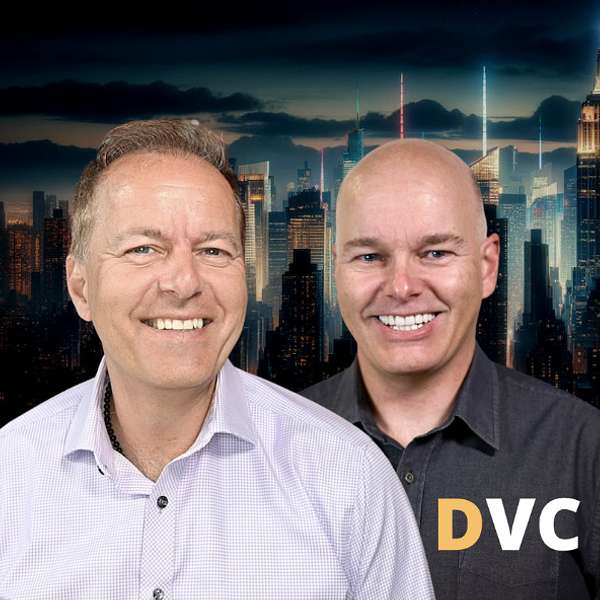
Digital Value Creation
The Digital Value Creation channel focuses on how AI and other tech makes an impact to create massive value.
Episodes are short and sweet, as we explore questions like this:
What are the emerging digital and AI trends? How do they impact business growth?
How can digital and AI transformation produce more value?
What is AI hype, and what is real?
How can you become a better AI leader?
How will all of this advance your opportunities?
How will we all benefit as a result?
Hosts - Tamas Hevizi and Arpad Hevizi
Digital Value Creation
Move Fast and Digitize Things
"Go Fast and Break Things" has been the mantra of disruptors since Facebook coined the term a decade ago.
Speed does differentiate industry disruptors from incumbents.
But is going faster enough to win the digital transformation race?
No. We need more than that.
Digital success needs the combination of speed, customer collaboration and positive business impact. Digital leaders like you and I must excel in all these three areas to win. Here is why.
"Go Fast and Break Things" has been the mantra of disruptors since Facebook coined the term a decade ago.
Speed does differentiate industry disruptors from incumbents.
But is going faster enough to win the digital transformation race?
No. We need more than that.
Digital success needs the combination of speed, customer collaboration and positive business impact. Digital leaders like you and I must excel in all these three areas to win. Here is why.
Rapid digital transformation became the norm in the pandemic. Before the crisis, many businesses did the opposite of what Facebook had suggested. In their initiatives they used to follow the “move slow and don’t rock the boat” mantra. Digital transformations often turned into endless pilots and science experiments. The results were too small to improve the business and to convince leadership to invest more. As business disruptions accelerated digital projects last year, the results reminded us what successful transformations could be like, the ultimate art of the possible.
If your business is not yet on the cutting edge of digital, what can you do to stay ahead of the competition?
Go For Speed
To use another software industry cliche: deliver early and deliver often. Delivering early means delivering before the competition, before it is perfect and before the customer expects it. Then you repeat it and get used to staying ahead. Speed is your friend, perfection is your enemy. The future is too unpredictable and those who move slowly to have a perfect solution will fall behind in innovation. By the time slow projects move from pilot to production, competitors will be far ahead. Expecting perfect information and thoughtful analysis is no longer realistic to create a competitive edge. Companies that go for speed get used to operating at a higher level of uncertainty. Given that uncertainty is becoming the norm, they will not be thrown off track by the next disruptor or crisis. What companies need is the rapid development of ideas, iterating work products, and pivoting when needed. Everyone has equal access to market information, talent, and customers. Digital technologies break down barriers and differentiation. Speed and time to market remain the biggest competitive edge. You can always course-correct if you are ahead of the game. If you are behind, your options are limited. Speed is now the norm and the slow simply cannot compete. Those who deliver good enough digital experiences faster will win. Aiming for perfection is the same as planning to fail.
Always Collaborate
Digital transformation requires a high level of collaboration and feedback loop with customers, partners and employees. The age of developing technologies for customers for a big ta-dah moment is over. Customer feedback needs to be real time during each iteration of a digital project. Customers co-create the experience they want from us. And then they will change their minds. And you will pivot. You will never ship a product for what the customer wanted last year. You will deliver for what they want today. The same real time feedback is expected with business partners that need to adopt to our business model changes. There is no time for strategic alignment sessions with partners. Don’t keep your suppliers and partners in the dark. Keep them in sync during the project the same way you stay in lockstep with your customers. Employee communication follows the same pattern. Instead of change management and training programs, real time digital transformation requires constant iteration and communication with our teams.
Maximize Value
Digital programs become transformational when they not only meet customer expectations but also the economics of the business. The digital processes you create have to be much more efficient than the status quo. The reason e-commerce, fintech or automation initiatives succeed is because they create an order of magnitude change on the profitability of the business model. Higher customer satisfaction needs to be paired with higher revenues and lower operating costs. For digital transformation has to change the profitability of the business to create true competitive edge. It is a lot easier for a competitor to mimic a commerce site or a chatbot, it is a lot harder for them to replicate the underlying efficient digital processes you created.
In the years ahead, companies will compete for both with their customer experience and the efficiency of their digitized processes. Digital transformation will drive an even bigger part of their competitive edge. Speed is the main differentiator of digital leaders. Those who can move faster, collaborate better with stakeholders, and create high-value impact on their businesses will have outsize returns.
So you and I should move fast, digitize everything, keep our customers in the loop and make sure all of it makes a giant dent in our markets.

